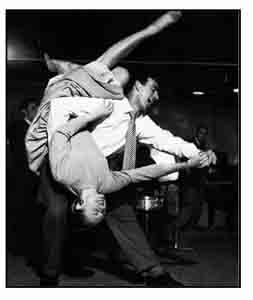 Most
of the Bandstanders learned FAST DANCING from older siblings, parents, and many
learned it from peers. The most common Bandstand-style swing seen on camera
was a 6-count pattern employing two tap-steps followed by a rock
step, and a distinct "lift" on the taps. The TRIPLE STEP pattern can indeed
be seen on some Bandstand "fast dance" Youtube videos, but it was less
commonly copied by America's teens! Also,for the average person, uptempo
rock and roll doesn't lend itself to triple-steps, neither then, nor now.
Most
of the Bandstanders learned FAST DANCING from older siblings, parents, and many
learned it from peers. The most common Bandstand-style swing seen on camera
was a 6-count pattern employing two tap-steps followed by a rock
step, and a distinct "lift" on the taps. The TRIPLE STEP pattern can indeed
be seen on some Bandstand "fast dance" Youtube videos, but it was less
commonly copied by America's teens! Also,for the average person, uptempo
rock and roll doesn't lend itself to triple-steps, neither then, nor now. New moves and new dances, such as The Strand and the Bop,"debuted" on Bandstand. Where did these dances come from? Here we have a continuation of the same old story that has grated on black dancers since the '20s. With a few exceptions, white teens, attending integrated school dances, "adapted" the moves from black teens, introducing the moves on Bandstand as their own (The '50s Bandstand crowd was 98% white). An important aspect of this "adaptation" involved another phenomenon well-known to black dancers: white males seemed to lack the hip-movement gene! They would try to imitate the black dancers, but in the words of R & B performer Hank Ballard, "They had a way of dancin' where they didn't move their hips. And if you dance without moving' your hips, it just ain't happenin'!"
Whitewash: Even if white girls could do the "hip thang", they were not allowed to do so on Clark's show. In the preceding SWING ERA as well, hot hip movement was considered very inappropriate for a "nice white girl." The original "Twist", for example, (pre-dating Lindy Hop many decades) involved LOTS more hip motion than Chubby Checker's Bandstand rendition. This is because Dick Clark gave Chubby (real name: Ernest Evans) the specific task of taming it for TV and the studio dancers.
Let's take a last look at the show and its legacy.
OK!